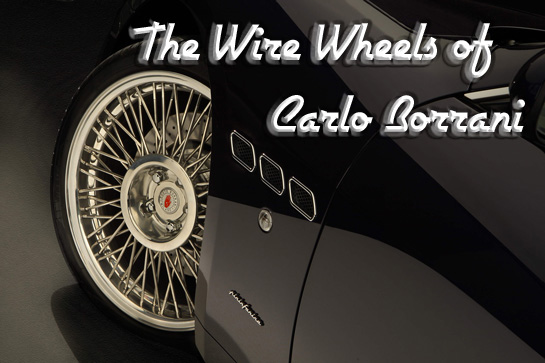
The latest wire wheel from Ruote Borrani is the X Ray, here making a big difference for the Maserati GTS.
In 2010, Borrani Americas partnered with Ruote Borrani Milano to be the exclusive importer and restorer of Borrani rims in North, Central and South America, thus bringing to the forefront a very relevant new story with a significant historical aspect that is rarely told. Our thanks to Ruote Borrani Milano, Borrani Americas, Roberto Motta, and David Seielstad for their help with this article.
For classic car enthusiasts, the name Borrani is synonymous with excellence. Their famed wire wheels have become an icon, known for quality, performance and design. In fact, the strength of Borrani is in its history and quality of its products. Borrani is still producing quality products, including their famous Borrani Classic wire wheels and new line of Xray, Sray and Bi Metal alloy wheels.
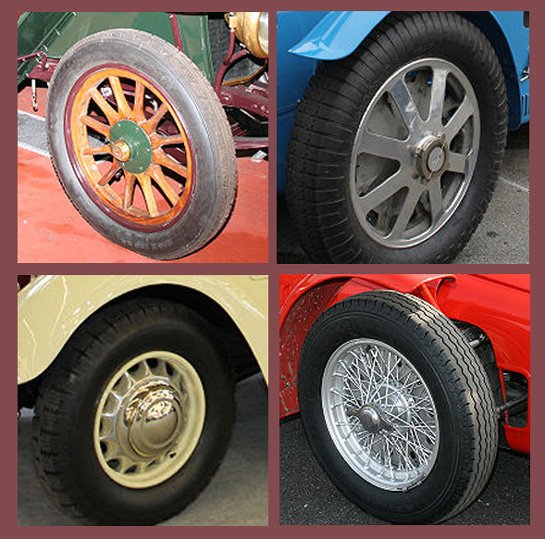
Wheels through the ages; 1914 wooden wheel, Bugatti, 1927, Peugeot, 1936, and Maserati 1951. Hugues Vanhoolandt photos
![rudge-3[1].-300](https://velocetoday.com/wp-content/uploads/2011/07/rudge-31.-300.jpg)
An advertisement from 1934. The 4CM 1100cc Maserati of Engineer and record breaker Giuseppe Furmanik sets a new record of 138.34 mph along the Florence-Pistola Autostrada using Borrani Rudge Whitworth wheels.
Borrani is the best known manufacturer of wire wheels, and they are also a large part of the history of the automotive wheel, a subject that is generally taken for granted. The automobile wheel has evolved from a wire bicycle wheel used on the small pioneering cars of Benz and Ford to a sturdy wooden-spoked affair capable of withstanding deeply rutted country roads. In the 1920s a lighter, pressed steel wheel which was widely used throughout out the industry and remains the stable for production cars today. In the 1950s, the use of all alloy aluminums and magnesium wheels became popular and that too, remains a constant to this day.
Borrani History
Overlapping this wheel evolution is the wire wheel. In use before the turn of the century, the wire wheel came into its own in 1908, when the British cycle company of Rudge Whitworth patented the method of a splined axle stub and locking central nut. The ability to change tires quickly was essential for racing and only Bugatti dared to leave the Rudge Whitworth fold with the spoked aluminum wheel of the Type 35. The center lock wire wheel was virtually universally adopted for racing, sports cars as well as many street and luxury cars, and remains with us today. Rudge Whithworth allowed its patent to be licensed. It remained for a wise and eager entrepreneur to expand the Rudge Whitworth patent to the European continent. Enter Carlo Borrani from Milan.
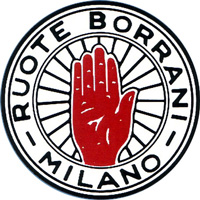
Founded on April 22, 1922 by Carlo Borrani with the objective to produce and market wheels for cars, motorbikes and cycles, “Rudge Whitworth Milano” was established in Milan having a share capital of 1,220,000 Lira. It was located Via Ugo Bassi 9.
In less than a year, Borrani wheels became the choice of leading race car manufacturers, as well as standard equipment or luxury options on the production cars of Alfa Romeo, Lancia, Mercedes Benz and many others.
Wire wheels were light, safe and strong; they could easily be engineered and constructed for a variety of widths and diameters, from a small motorbike sized wheel for a Fiat 500 “etceterini” to the rear wheels of the giant 400 hp Mercedes Benz Grand Prix cars of the 1930s. In the 1930s Borrani began experimenting with light and rigid aluminum alloys for the wheel rims which would replace the traditional steel rims. By the late 1930s, the company changed its name to Carlo Borrani S.p.A.
Borrani supremacy
Borrani’s wire wheels seemed endless, ageless, and added beauty and class to almost any vehicle. They were painted or chromed, had aluminum rims or steel rims, were outfitted with a hexagon lock nut that used a large socket, a two eared flat “knock off” that was removed and fastened with a soft hammer, and finally a beautiful outward angled three eared knock off that was a focal point of the 1962 Ferrari GTO. Ironically, in the 1920s and 30s the beauty of the wire wheel became so common that a new industry was created to produce elaborate and attractive cover to hide the wire wheels!
Throughout the 1940s and the 1950s the wire wheel rolled supreme at Ferrari and most other high performance and sports car manufacturers (Maserati offered the Borrani ‘bi metallic’ discs—steel discs with aluminum rims– as standard equipment on the production 3500 and wires as an option). It was a grand tradition… any sports car worth its salt simply had to have wire wheels and very few escaped the trend (Corvette and Porsche being notable exceptions).
Growth continued and in the 1950s, the company again changed its name, to “CMR” Construzioni Meccaniche Rho S.p.A., but the wheels still were linked to the Ruote Borrani Milano trademark. Production increased from 1000 to 1500 wheels per month with Ferrari being the biggest customer, and a full ten percent of production was allocated to racing car wheels.
Borrani does Detroit
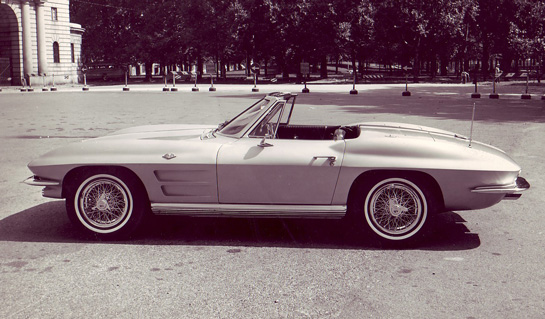
The one that got away. Corvettes never came with wire wheels, but Borrani supplied a hub kit for many GM cars. Courtesy Ruote Borrani.
Into the seventies, Borrani offered four different models of wheels:
Standard: Center lock wire wheel with steel rim
Record: Center lock wire wheel with aluminum rim
Bolt on: Special wheel with direct mounting wheel bolts
Kit Transfer: Conversion kit to Rudge center lock system
Detroit beckoned. Did you know that you could get Borrani wire wheels for your GM car? Those Kit Transfers were designed for many Buicks, Cadillacs and Chevrolets built from 1946 to the mid 1970s.
Gone in sixties seconds
Perhaps nothing so beautiful could last forever. Would the wire wheel go the way of the wooden spoked wheel? Demand for wires seemed to peak in the late 1960s, and the aftermarket alloy and magnesium wheel became popular for street cars. In Grand Prix racing, where the wire reigned supreme, changes were afoot. With the appearance of Lotus, Cooper, the roadster at Indy, the wire wheel in Formula One racing was soon gone, replaced by the Lotus “wobblies” (so called because of the wavy or “wobbly” design). There were early signs; the Type 35 Bugatti in 1924, the first post war appearance of Formula III Cooper 500s with strange looking aluminum wheels, BRM discs in 1957-8 and Vanwall wobblies shortly thereafter. But few ever thought that the wire wheel would ever be replaced. But 1963, they would vanish from the Grand Prix scene forever. The same trend would affect sports cars and GT racing, but it took a few more years.
And what was the reason? Magnesium alloy wheels were stiffer. Along with the rear engined revolution came better handling, and stiffer wheels contributed in no small part to that improved road holding. Mags were also much lighter, and at first they even discarded the center locking wheel nut in favor of lighter but slower four and five lug nuts. As technology improved, alloy wheels with one center nut became the norm. So one of the Borrani/Rudge Whitworth traditions is still with us, for it would be very difficult to change all four wheels in 3 seconds without a single center nut.
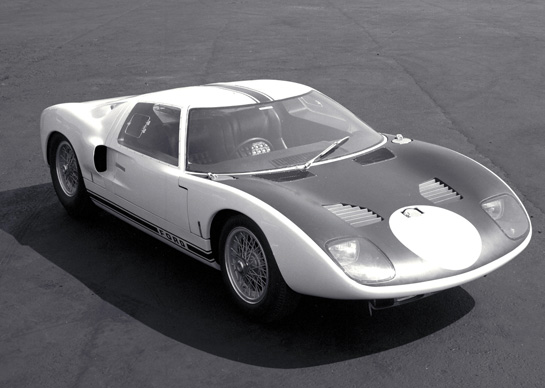
Borrani not only equipped Ferrari but the new Ford GT, seen here in 1964. The GT40 ran Borranis but mags were used from 1965 on.
Back on the street, another nail in the coffin of the wire wheel was the effect of USA DOT regulations in the 1970s which forbade the use of those wonderful knock off nuts. So if you wonder why the only street knock off nuts are now earless, that’s why.
But Borrani survived to remanufacture and rebuild wheels for the rapidly growing classic car hobby. Just as the demand for new wire wheels was diminishing, Ferraris were among the first post war classic cars to become extremely desirable, and almost all pre 1975 Ferraris used Borrani wire wheels. Borrani was there to serve the needs of a new generation of old Ferrari owners. Timing is everything!
To facilitate this growth and to provide an outlet for the new line of Xray, and Sray wheels, Borrani Americas was established in 2010 to partner with Ruote Borrani Milano to be the exclusive importer and restorer of Borrani rims in North, Central and South America through the parent company, Motion Products Inc. of Neenah, Wisconsin, a firm already well known for its superb Pebble Beach quality restorations. Their website is Borraniamericas.com
Click here for Borrani’s Facebook page
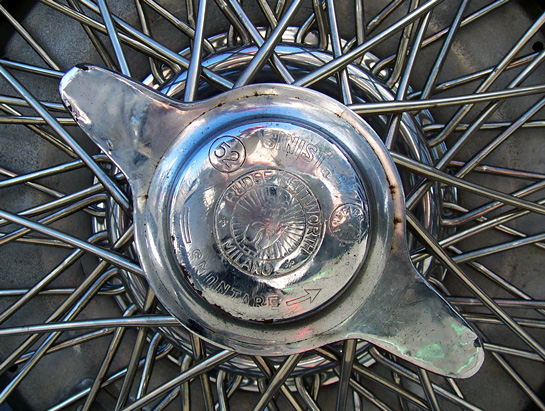
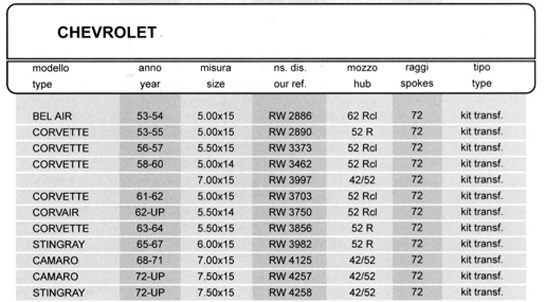
Pete,
You said that there were no Borrani wheels for Porsche? Not so!
In 1959 I stopped at the Nardi shop in Turin to buy a few Nardi wood rimmed steering wheels for Porsches. While there with my new 1600 Super, I spied some 3-eared Borrani wheel nuts which I bought, since my Porsche had the factory knock-off wheels. Mr Nardi said that he would sell them to me but I could not return to Germany with them on the car. OK, I said to wrap them up for me. He
also tried to sell me a st of Borrani wire wheels for my car. My finances were running low as I spent a lot on engagement and wedding presents for my soon-to-be wife.
I still have the 3-eared knock-offs for Porsches squirrelled away in my garage somewhere.
Pete,
What happened to my comments?
Well, we can answer that…now, anyway. A severe storm hit us right upside the head on Thursday and we lost all power, cable and telephone service until last night. Since I have to post each comment, there was no way to do so until today.
Have not checked on Porsche Borrani, but no doubt you are right for there is always an exception that proves the rule. Borrani would have made up hubs to fit just about any car on spec. The wheels were then the standard wires.
Der sir.
I´m restoring an set of Borranis seriel n:r 3912 tobe used on my Aston DB 6.
My question is what car where origin they fitted to.
Best regards / Kare